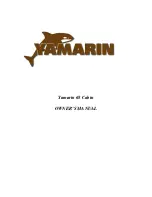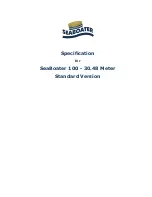
10/100
Category A: At high sea
This craft is designed to operate in winds that may exceed wind force 8 (Beaufort scale) and in
significant wave heights of 4 m and above.
This craft is largely self-sufficient. Abnormal conditions such as hurricanes are excluded.
Such conditions may be encountered on extended voyages, for example across oceans, or
inshore when unsheltered from the wind and waves for several hundred nautical miles.
Category B: In open sea
This craft is designed to operate in winds up to Beaufort force 8 and the associated wave
heights (significant wave height up to 4 m, see Note 1 below).
Such conditions may be encountered on offshore voyages of sufficient length, or on coastal
waters when unsheltered from the wind and waves for several dozens of nautical miles.
These conditions may also be experienced on inland seas of sufficient size for the wave height
to be generated.
Category C: Near to the coast
This craft is designed to operate in winds up to Beaufort force 6 and the associated wave
heights (significant wave height up to 2 m, see Note 1 below). You may meet with such
conditions in exposed inland waters, in estuaries and in coastal waters with moderate weather
conditions.
Category D: In sheltered waters
This craft is designed to operate in winds up to Beaufort force 4 and the associated wave
heights (occasional maximum waves of 0,5 m height).
Such conditions may be encountered in sheltered inland waters, and in coastal waters in fine
weather.
NOTE:
- The significant wave height is the mean height of the highest one-third of the waves, which
approximately corresponds to the wave height estimated by an experienced observer. Some
waves will be double this height.
- The creation of different design categories results from the need to distinguish between
different levels of risk according to the construction of the boats.
The parameters for the characteristics are established to define the conditions of navigation
which each category may encounter; they serve purely to evaluate the boat designs and are
not to be used to limit the geographical areas in which these boats may operate..
- One boat may be classed in several design categories at the same time, each with their
different maximum capabilities.
Summary of Contents for LEADER 8
Page 1: ...LEADER 8 OWNER S MANUAL S PORTS ET LOISIRS 091683 Index E...
Page 2: ......
Page 4: ......
Page 8: ......
Page 10: ......
Page 16: ......
Page 26: ......
Page 30: ...26 100 SUPPLY VALVE FUEL Location On the fuel tank Remote pull switches Fuel supply valve...
Page 34: ......
Page 35: ...31 100 HULL MAINTENANCE OF THE HULL LIFTING 3...
Page 38: ......
Page 48: ......
Page 49: ...45 100 STEERING SYSTEM STEERING GEAR 5...
Page 52: ......
Page 53: ...49 100 INTERIOR INTRODUCTION INTERIOR MAINTENANCE MAINTENANCE OF FABRICS 6...
Page 54: ...50 100 INTRODUCTION DECK SALOON INTERIOR ACCOMMODATION...
Page 56: ...52 100 Saloon Mosquito net Blackout curtain Work top Sink...
Page 58: ......
Page 60: ...56 100 WATER TANK Location Aft cabin Capacity 100 litre Deck filler...
Page 64: ......
Page 66: ...62 100 Drain to sea Deck drainage Seawater inlet WC Location Saloon cupboard...
Page 71: ...67 100 ELECTRICAL EQUIPMENT 12 V DC SYSTEM ELECTRICAL CIRCUIT 110 220 V EQUIPMENT ELECTRONIC 8...
Page 82: ...78 100 ELECTRONIC LAYOUT OF COMPONENTS Lead lines Loch speedo sounder...
Page 84: ......
Page 85: ...81 100 ENGINE GENERAL INFORMATION ENGINE FITTING 9...
Page 95: ...91 100 LAUNCHING LAUNCHING RECOMMENDATIONS 10...
Page 96: ...92 100 POSITION OF HOISTING CRADLE AND STRAPS Note Measurements are expressed in mm...
Page 99: ...95 100 WINTER STORAGE LAYING UP PROTECTION AND MAINTENANCE 11...
Page 102: ......
Page 104: ......















































